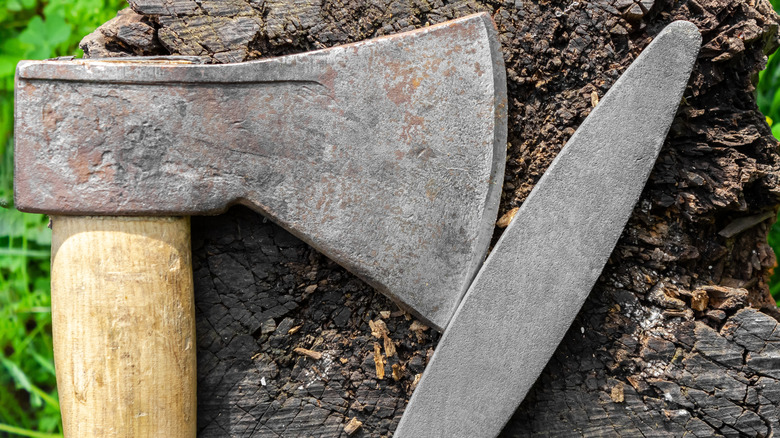The Over-Complicated Axe Sharpening Method To Avoid, And What To Do Instead
We may receive a commission on purchases made from links.
When you think about how to sharpen an axe to perfection, does your mind go back to the old homestead? Metal against stone, sharpening the tip to an X point for optimum chopping! If the idea of axe sharpening doesn't evoke images of lumberjacks and pioneers, you may think of more traditional methods like grinding stones or files, but other interesting techniques have been posted online and on social media. One such video depicts the use of a sharpening jig, and while creative solutions like these can be tempting, an exclusive interview with House Digest's expert carpenter and remodeler Bob Beacham confirmed that this one is perhaps a bit too creative.
"In principle, using a jig to maintain a consistent angle between whetstone and blade is a good idea," Beacham said. The method seen in Sam Home's YouTube video, though, isn't the safest. Beacham said the components aren't steady enough, and the setup is "overcomplicated and impractical."
Breaking down the video, Beacham explained, "The guy is attempting to create an axe sharpening jig. ... He drills a hole in a whetstone and glues in a piece of wire. He then puts an L-shaped metal bracket in a vise and threads the wire through. He puts the axe head on the [back] of the vise and rubs the whetstone across it to sharpen it." The issue is that the setup is unsteady, and Beacham chalks this up to several factors.
Avoid impractical and overcomplicated methods of axe sharpening
During his exclusive interview with House Digest, Bob Beacham explained that failing to secure the axe was a curious choice on the part of the video's narrator. "Usually you would either fix the blade in the vise, clamp it to a bench, or sit holding it flat on your thigh," he said. The YouTube video is also missing key elements, like the fact that there is "no indication of the length of the wire or the size of the bracket so the sharpening angle could be off."
According to Beacham, this isn't the only issue with this technique. He noted, "The wire is loose in the hole, so the sharpening angle may not be consistent [and] the bracket is poorly held; it looks like it would fly off at any moment." In the video, the narrator adds WD-40 to lubricate the whetstone, and Beacham said this "[would] ruin it. It should be water or oil." He also noted that you would need a diamond drill bit if you plan to drill into whetstone.
Because this method seems so impractical (and a little unnerving), Beacham offered alternative ways to effectively sharpen an axe. "[There's] nothing wrong with using a whetstone," he explained, and if you use a whetstone to sharpen your axe by hand, "you don't need anything else." He added, "Some prefer a sharpening puck for axes because it's a nice hold," citing the NedFoss Axe/Hatchet Sharpening Puck as a solid choice.
Traditional tools work well to sharpen an axe
If you're concerned about how much it costs for the pros to sharpen an axe, Bob Beacham had some expert advice for performing the task yourself during his exclusive House Digest interview. "You don't need anything complicated, just focus and patience," he said. "Sharpen on the push stroke. Don't rub backward and forward because you will tend to rock the stone and round off the edge." Beacham added that while securing the axe is advisable, it's not necessary. "Thighs have been used for generations," he said, "but if you're worried, use a vise or clamp the axe to a bench."
He also recommended using a block of wood "under the blade to raise it up from the bench surface." Beacham noted that consistency is key, and said, "When sharpening, concentrate on the interaction between whetstone and the edge ... Don't rush." He also cautioned to "Work away from the blade, not [toward] it, so if you slip your hand just goes into thin air." Beacham says that knife gloves can help if you're worried about getting cut, such as NoCry Premium Cut Resistant Gloves.

